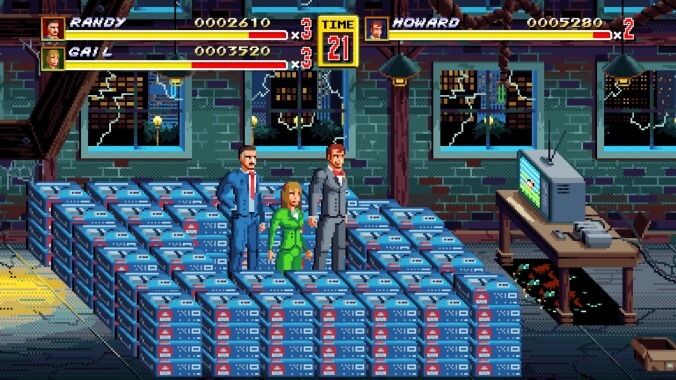Blast processing was a lie. It’s sad but true: Despite its evocative name—and a million playground arguments about how it allowed the Sega Genesis video game console to do what Ninten-didn’t in the early ’90s—the vaunted technology was really just a useful bit of computing speak, plucked out of the mouths of programmers and used by marketers as a bludgeon against the competition. With those buzz words, Sega managed to eclipse its main rival in the American video game market in the early 1990s, briefly toppling a company that was so ubiquitous Stateside that “Nintendo” is still sometimes used as a synonym for any video game, regardless of what system it operates on.
This era of upheaval, corporate rivalry, and, yes, a few outright lies to the public serves as the focus of Jonah Tulis and Blake J. Harris’ documentary Console Wars, which attempts, semi-successfully, to cover a time period when video game executives were happy to snipe bitterly at each other in front of Congress, or film a video of themselves blasting a rival company’s beloved mascot with a gun. Based off Harris’ 2014 book of the same name, the film uses archival footage, modern-day interviews, and plenty of original animation (intended to look vaguely video-game-like, to varying degrees of success) to illustrate a sometimes scattershot story of marketers at war in an industry that was rapidly evolving into a massive-money business. And, just like the games of the era, Console Wars is bright, engaging, and frequently so fast-moving and unfocused that it might give you a headache.
As in the book, Harris and Tulis adopt as a framework the rise of Sega Of America, and especially CEO and resident pitchman Tom Kalinske. Kalinske was heralded as the savior of toy company Mattel in the early ’80s, after reinvigorating the Barbie line of products and introducing He-Man to the world. That miracle worker reputation is exactly why Sega’s Japanese leadership approached him in 1990, in hopes of reviving their failing U.S. console games business after years of toiling fruitlessly in Nintendo’s wake. Still a charismatic and engaging speaker 30 years later, Kalinske and his team lay out for the cameras how—when faced with a competitor blatantly unafraid to use its massive market share to “encourage” retailers not to grant shelf space to rival products—they developed a high-volume marketing blitz designed to appeal to teens and paint Nintendo as a company solely for little kids. And if there’s no mention of “games” in that plan, that’s one of the savvier points Console Wars ends up making, amidst all its little digressions and tributaries: This was a battle of advertising, not software, and the advertisers and executives are its clear and obvious heroes.
Tulis and Harris make the natural decision to center their narrative on Team Sega. Sega Of America enter the story as heroic underdogs, exit it as cheerful-but-possibly-sabotaged failures, and—almost to a person—come off as far more likable than the various cigar-loving suits who ran Nintendo during the era in question. (The sole exceptions are Nintendo Power founder Gail Tilden and the company’s resident “game master,” Howard Phillips, who’s enthusiastically dorky in both the present-day interviews and archival footage of his bow-tied younger self.) But that same decision to center this as “the Sega story” also needlessly complicates Console Wars’ timeline. The effect is less “in media res” than “Oh shit, we forgot to tell you this part,” as when the movie suddenly jumps back, halfway through its runtime, to the infamous video game crash of 1983 (complete with obligatory mentions of the landfill-destined E.T. Atari game) in order to explain how Nintendo got to its position of eventual dominance. Similarly, the film struggles to incorporate the eventual winners of the Console Wars: Playstation manufacturer Sony, which sold nearly twice as many consoles in the mid-’90s as Nintendo and Sega combined. Tulis and Harris seem as blindsided by their intrusion into the narrative as Sony’s business competitors were back in the day.
Console Wars never quite settles on the story it’s trying to tell. Is it the one about billion-dollar companies poking at each other like immature children? A David-and-Goliath tale? (Albeit one in which both David and Goliath eventually find themselves getting kicked around the block by Crash Bandicoot?) A sly analysis of how savvy, aggressive marketing can hold far more sway over the minds of children than any blood-soaked Mortal Kombat match? Tulis and Harris don’t seem to have enough material to make a full film out of any of these ideas, and so they settle for a messy compromise that veers from corporate espionage to cringe comedy to attempts at uplift. (Their lack of focus extends to the film’s editing, which is often hyperactive to the point of distraction.)
What they do have, though, are interesting anecdotes, some fascinating characters, and a whole bunch of still-bizarre ads from an era when punk-adjacent “attitude” was slathered liberally over a billion-dollar industry by a bunch of people who spent large swaths of their lives living out of Comfort Inn suites and sweating in unattractive suits. It’s not for nothing that one of the most consistently entertaining talking head interviews comes from Jeff Goodby, the outside advertiser who crafted Sega’s revolutionary “Welcome To The Next Level” campaign (and who did as much to make “blast processing” a ubiquitous-if-meaningless phrase as anyone on Earth). Wry and unashamed, Goodby grasps the real truth: These marketing wars were always just another kind of very expensive game. Console Wars could use a little more of that clear-eyed honesty about the industry and era it’s trying to document.


